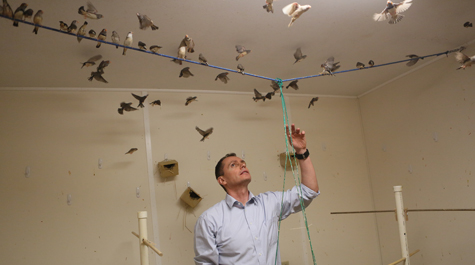State of Virginia invests matching funds in Swaddle’s Acoustic Lighthouse technology
William & Mary biologist John Swaddle will receive nearly $100,000 in matching funds from the state of Virginia to develop technology to reduce the toll that wind turbines take on birds.
Swaddle’s award was announced recently by Virginia Governor Ralph Northam as part of $2.7 million in funding in support of 34 Commonwealth Research Commercialization Fund (CRCF) awards. The slate of awards also included $83,207 to Standish Allen at VIMS for “Progeny Tests of Triploids to Establish Additive Advantages from Tetraploid Parents for Commercial Oyster Culture.”
The CRCF funding will allow Swaddle to field-test prototype versions of his Acoustic Lighthouse, technology designed to warn flying birds away from deadly collisions with tall structures such as wind turbines.
“The Commonwealth Research Commercialization Fund accelerates technological innovation and economic growth in Virginia by identifying potential solutions to important state and national problems,” Governor Northam said in a release. “The CRCF is a great example of how the public-sector can leverage outside resources and innovation to serve citizens better. I commend these recipients and look forward to seeing their projects come to fruition.”
The governor’s release noted that the CRCF awards support initiatives in six industries: biosciences and medical technologies, cybersecurity, clean energy, water quality, data analytics and unmanned systems.
Swaddle, a professor in William & Mary’s Department of Biology, received $99,771 in matching funds under the energy category for his application titled “Developing Acoustic Technology to Reduce Birds’ Risks of Collision with Wind Turbines: Expanding Wind Energy Opportunities in Virginia.”
Swaddle explained the principles of Acoustic Lighthouse in both a presentation and a press briefing at the 2018 annual meeting of American Association for the Advancement of Science, the world’s largest scientific society.
He pointed out that millions of birds die each year in collisions with manmade structures. Wind turbines are often sited along migration flyways and other windy areas, setting up a scenario for avian disaster. Swaddle explained a flying bird’s natural posture arranges the bird’s anatomy so that the creature is looking down — not where it’s going. Swaddle’s Acoustic Lighthouse uses sound to get flying birds to glance up, see the obstruction — and avoid it.
Swaddle has tested his devices successfully with captive birds in the William & Mary aviary. The next step, thanks to the CRCF awards, will be to deploy the devices on cell phone and communication towers on Virginia’s Eastern Shore.
“We think that such towers are a decent proxy for a wind turbine and is a necessary test before approaching power companies to design and implement a full-blown test of the Acoustic Lighthouse on actual turbines,” he said.
The Eastern Shore is an excellent site for the test, he explained, as it is both prime siting for wind turbines and includes a large stretch of the Eastern Flyway, a busy route for migrating birds.
Swaddle said he expects to publish the results of his field test in a peer-reviewed journal and proceed with filing a full patent on the Acoustic Lighthouse technology.
“We’ve been approached by several international companies who are interested in the Acoustic Lighthouse concept. Some of these companies are already well established in areas of bird deterrence and/or alternate energy. It is too early to talk openly about who these companies are,” he said.















